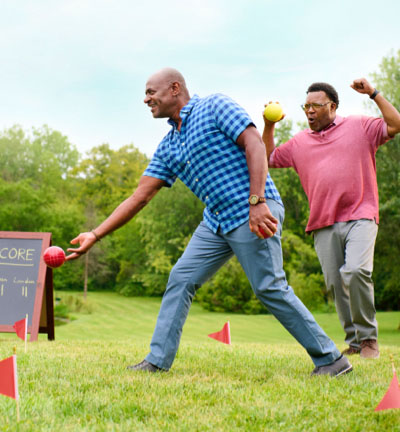People living with myasthenia gravis (MG) can experience a range of symptoms including ocular (or eye-related) symptoms.
There are several different types of MG, but two of the main forms are ocular and generalized MG.1
Ocular MG affects the muscles that move the eyes and eyelids.1 Up to 85% of all people living with MG have ocular symptoms initially.2 And, in some people, ocular MG progresses into generalized MG.3,4 Common symptoms of ocular MG are double vision (diplopia) and drooping eyelids (ptosis).5
If a person has generalized MG, they typically experience symptoms that impact many areas of their body. Their symptoms can include upper and lower body muscle weakness, trouble chewing, swallowing or speaking. They also might have difficulty doing everyday tasks, such as climbing stairs or brushing their teeth. Additionally, people living with generalized MG may experience ocular symptoms, as well.5,6
Eye-related symptoms can affect peoples’ lives in different ways—from work, to driving, to reading and more. With eye problems being a common challenge for those living with MG, finding a qualified eye doctor may be a priority.7 Neurologist Dr. Charulatha Nagar* says, “If you need glasses or contacts, make sure you wear them and are up to date with your eye prescription. This may help prevent strain and discomfort.”
With MG, ocular symptoms like droopy eyelids, blurred or double vision, and trouble focusing can happen when your eye muscles become weak.5 These steps might help:
- Wearing sunglasses to protect from bright light
- Using screen readers, which read words on your screen aloud
- Adding eyelid crutches to your glasses, which can help hold your eyelids open
Personal experiences with eye-related symptoms
Tom* who lives with MG says, “Prior to being diagnosed I had actually been living with double vision, but I didn’t know it was MG. I just thought I was getting older.” He goes on to say, “As my symptoms progressed, I started trying to figure out what was going on; it was my eye that really caused me concern. My right eye was pointing straight up, and my right eyelid was pulled down. Since then, of course, I've been diagnosed with generalized MG and my right eye is still extremely bothersome on a regular basis, but I’ve learned how to better deal with it.”
Tom shares, “The double vision is what’s the most bothersome because everything to me is blurry and if I'm really tired, my double vision will get more prominent.”
If you’re struggling with double vision with your MG, talk to your eye doctor about adaptive eyewear, which may include8,9:
- An eye patch
- A piece of masking tape behind one side of sunglasses or eyeglasses
- A prescription for prism glasses
Courtney*, who also lives with MG, shares, “I experience symptoms, mainly double vision, at least once a day. I have had consistent symptoms for the last 10 years. The double vision for me is just in my right eye.” She goes on to say, “Sometimes my eye will become so weak that it will roll and point toward the middle of my face.” Courtney has been living with MG for over 20 years. Reflecting on the early years, she says, “My eyes felt the most strained when I was driving. So, because of that, I made the decision not to drive just because it's safer and less stressful for me.” Giving up driving may be a deeply personal decision but it’s important to note that if you have any concerns about driving while living with MG-related ocular symptoms, you should talk with your neurologist.
Courtney describes how her life has changed since that tough decision years ago, “I remember not being able to imagine a life without driving. But, since giving it up, I will say I walk a lot more than I used to and I actually enjoy it.”
Vision disruptions are among some of the more common MG symptoms that may take a toll on a person’s self-esteem.10 “I'm part of a book club and there have been times when it has been tough to read because of my double vision,” Courtney says. “But I keep reading because I love the books we pick out and completing the book by the deadline despite my symptoms makes me feel good.”
Audiobooks and podcasts are also great options to give your eyes a break when needed. And there are other things you can do that may provide you with a greater sense of agency when it comes to your MG, like tracking your symptoms.
When I feel fatigued, I do something that doesn't strain my eyes, whether that’s listening to a video or just relaxing my eyes while I’m on the phone with a friend.
Tracking your vision and eye-related symptoms and knowing your normal
The Myasthenia Gravis Activities of Daily Living (MG-ADL) scale is one of many ways to track MG symptoms. It’s made up of eight questions, which are about daily activities. It also keeps ocular symptoms in mind as the last two questions are eye related.6 Each item is measured on a scale of zero to three, with a score of zero representing normal function and a score of three representing the greatest severity of symptoms.
To find your MG-ADL symptom score total, assess the result for each question and then add all eight scores together. The total score can range from zero to 24 points—in general, the lower the score, the less one’s daily activities may be impacted.6 A score of zero or one on the MG-ADL scale is considered minimal symptom expression (MSE).11 While MSE may be a good goal to strive for, it is not an end destination, and symptoms may change.5
Using the MG-ADL can provide a clearer way to identify and discuss your ocular symptoms with your healthcare team and loved ones. The different severity levels of double vision and eyelid droop that are measured by the MG-ADL scale are as follows:
- Score of 0: No symptoms
- Score of 1: Symptom occurs, but not daily
- Score of 2: Symptom occurs daily but is not constant
- Score of 3: Symptom is constant
Consistency with tracking is essential to better understand symptoms, their impact and how they can change over time. Also, answering these eight questions with your doctor can help better reveal how MG affects you every day. “My doctor and I use the MG-ADL scale together,” says Courtney.
Communicating with your loved ones and healthcare teams
In addition to using the MG-ADL to fuel better conversations, there are other ways to improve communication. Courtney says, “Other people don't always know how I’m feeling or if my ocular symptoms are acting up.” She continues, “So if I need something, I’ll just ask someone, ‘Hey, can I get a ride?’ I mean, the worst thing they could tell me is no.” Courtney shares that communicating and being honest about her eye-related symptoms has had good results for her and her support system, “My friends have been really good about showing up for me. I have a great network of friends who will give me rides.”
When it comes to support systems, Dr. Nagar suggests, “If you live with someone who has MG, giving them rides and helping them with chores around the house can enable them to have some much-needed rest time. It can also help alleviate emotional and physical stress.”
Dr. Nagar also recommends having conversations with your healthcare teams and asking questions. “Visit your eye doctor regularly to ensure your prescription is correct and ask them for tips to reduce discomfort,” she says. “You should also talk to your neurologist about your current treatment, advancements in the treatment landscape and treatment strategies.”
Tom shares how he advocates for himself in appointments. “My recommendation would be, don’t be afraid! If you're not understanding something or something's not quite right, you should feel empowered to speak up.” But he admits it can be difficult at times, not just speaking up for yourself but also living with MG and eye-related symptoms. He believes working with a mental health expert can be helpful. “Talking with my therapist has really helped me. I think it’s important to have mental health support along with physical healthcare support. I believe somebody in the mental health world may be helpful if you’re living with a rare disease, especially if your vision affects your ability to work.”
If you’re living with a rare disease, communication with your loved ones and your healthcare team is so important. But how you talk to yourself is important, too. “Try to talk to yourself like you would to a friend,” encourages Tom. “Often, we're the most critical about ourselves. Try to give yourself grace in terms of the way you look at yourself.”
If you have ocular symptoms, be sure to verbalize what you need because people don't always know how to help.
Download the MG vision and eye symptoms discussion guide for helpful hints, tools and tips that may make hobbies and activities easier if you’re living with ocular symptoms. And, as every case of MG is different, be sure to discuss everything in detail with your neurologist.













